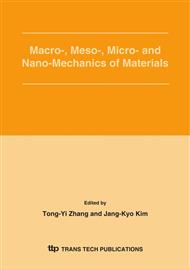p.79
p.87
p.93
p.101
p.109
p.117
p.127
p.137
p.143
Effects of Gun Tube Profile and Sabot on Stresses and Velocity of Long Rod Penetrator
Abstract:
The paper describes the combined influences of the forward sabot diameter, sabot modulus, and L/D on the stress of the projectile rod traveling in the gun tube. Three types of gun tube profile were simulated. The first profile is perfectly straight. The second profile is monotonously curved tube only by gravity loads (Type A). The third is a changeful curved tube by gravity loads with imagined as-manufactures (Type B). Three-dimensional dynamic finite element analysis method was used for the sabot/rod system transiting in a gun tube. Numerical simulation results showed that the maximum von Mises stress due to in-bore behavior of the sabot/rod system could be decreased by changing the forward sabot diameter in a type B tube. The effect of tube centerline profile on the stress of the rod was analyzed for the conditions mentioned above. The von Mises stress of the rod in the changeful curved tube is as much as 10% higher than that in the straight or monotonously curved tube.
Info:
Periodical:
Pages:
109-116
Citation:
Online since:
September 2005
Authors:
Price:
Сopyright:
© 2005 Trans Tech Publications Ltd. All Rights Reserved
Share:
Citation:


